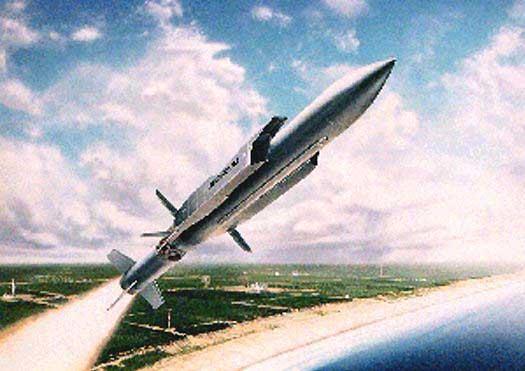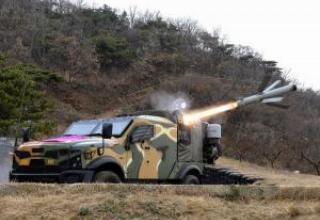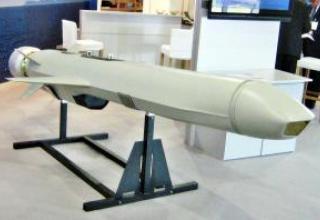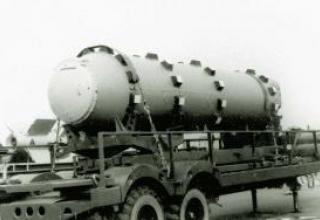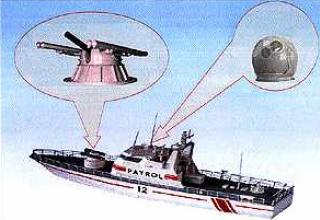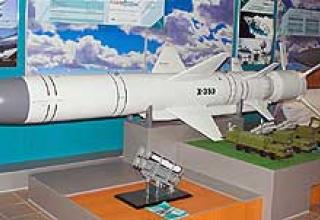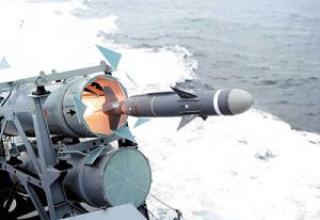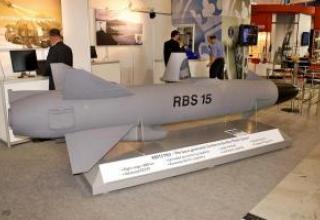An agreement to jointly develop a prospective anti-ship missile was signed by France, the United Kingdom, the Netherlands, Norway, the United States and Germany in April 1977. The tactical and technical requirements established that the range of the future missile would be 180 kilometres at a cruising speed of M=2. But in a few months, for political and financial reasons, the parties to the agreement began to refuse to continue the project, as a result, from mid-1980, research and development of the missile designated ANS (ANS - Anti-Navire Supersonique, "supersonic anti-ship missile") was conducted only by French and West German specialists. The French Navy reserved the designation MM-100 for the missile. The work was funded in equal shares by four participants: the French and German governments and the firms Aerospatiale (France) and Messerschmitt-Bolkow-Blohm (MBB, Germany).
Despite the successful launch of the ANS Direct Flow Airjet Propulsion (DAS) demonstrator on the French test site in 1989, the French government withdrew further funding for the project in 1992. As a result, the main contractor of the ANS project, Aerospatiale, stopped developing the missile without giving up plans to create long-range supersonic SIRBMs.
As a priority option for the implementation of these plans was chosen the direction of deep modernization of the ASMP missile, created by "Aerospatiale" to equip the French Air Force strategic forces. The revised version was originally named by the developer of ASMP-C ("Conventional" - "non-nuclear", because, unlike the original model, equipping the sea version of the missile with a special warhead was not provided), and then, after the resumption of funding by the French government, the project has already been officially assigned the designation ANF (ANF - Anti-Navire Futur, "anti-ship missile of the future").
In October 1994, Aerospatiale and Deutsche Aerospace (DASA, Germany) formed a consortium for the joint creation of supersonic ANF-based Aerospace, which within the consortium was renamed ANNG (ANNG - Anti-Navire Nouvelle Generation, "anti-ship missile of the new generation"). In 1995, the name of the project was changed once again, and it is now called "ASURA". Within the consortium Aerospatiale is responsible for the development of the glider and engine of the missile, as well as for the homing system for the final trajectory. The West German company LFK (Lenkflugkorpersysteme), a DASA subcontractor, will develop the missile's warhead and navigation system, as well as carry out the necessary upgrades of existing launchers to accommodate the ASURA.
Composition:
The "ASURA" rocket has a cylindrical body. The VESTA direct air jet engine (VEcteur a STAtoreacteur) provides the missile with a cruising speed of about M=2.4 at low altitude and up to M=3 at high altitude. The lifting force created at supersonic marching speed by two developed air intakes is sufficient to maintain the missile's stability on its trajectory, so the wings as such are not provided in the missile's design. Instead, the ASURA has four small stabilizers located crosswise at the tail end of the hull.
The design of the rocket should provide an opportunity to use for storage and launch of the new rocket transport and launch containers PKR "Exocet" MM-40 and ITL launchers of rockets family "Exocet". For this purpose, "ASURA" has folding stabilizer arms.
VESTA jet engine, which is equipped with the rocket "ASURA", was created at one time for the ASMP and combines a direct-flow engine with a solid fuel accelerator, placed directly inside the combustion chamber of the SARD (as it is done in the rocket 3M80 "Mosquito"). During its operation - 5 seconds - the accelerator provides acceleration of the rocket to a speed of M=2, which makes possible the operation of SVAC. Approximately 1/20 sec after the end of the accelerator operation, its nozzle is reset, after which the rocket propulsion system switches to the SAR mode in a fully automatic mode. As a fuel, the SARP uses standard aviation kerosene JP-5 - unlike the engine developed for the ANS missile, which operated on a specially created liquid rocket fuel with high specific gravity.
The air to the rocket's engine is supplied by two long - more than two thirds of the rocket's length - rectangular air intakes located not on the sides as on the ASMP, but on the top and bottom of the hull - this was done in order to increase the rocket's maneuverability at extremely low altitudes. (An interesting detail is that in the design of the air intakes of the ASURA marching engine, the air intakes of the Concorde supersonic passenger aircraft engines were used as a model). The chosen design of air intakes made it possible to implement the so-called "vortex" combustion chamber in VESTA RVD - stable fuel combustion is maintained in it due to the vortex, which is formed by connecting air flows from two air intakes and creates a kind of "walls" to hold the torch.
Two solid fuel accelerators are placed on the side of the engine compartment of the rocket to be launched from the ship's launcher. The length of each accelerator is approximately 2.1 m and its diameter is approximately 0.22 m. Additional stabilizing surfaces are expected to be installed at the tail end of each of the accelerators.
The ASURA missile's range is about 80 km when flying in the "low altitude" profile; if flying in the "low altitude" or "high altitude" profile, the range can reach 150 km. In the future, the range can be increased up to 185...370 km when flying along the optimal profile.
The "ASURA" is designed for both surface ships and submarines. According to the existing plans, surface ships will be equipped only with the anti-ship version of "ASURA", while for the PL, in addition to the anti-ship version, it was planned to create two more versions of the missile - to engage ground targets with pre-defined coordinates and with a passive radar self-direction head to engage the radar (both ship-based and ground-based).
In the forward part of the anti-ship version of the missile under the ogival-shaped head fairing there is an active radar homing head ADAC Mk II, similar to the CNS, which is currently equipped with PCR "Exocet" MM-40 Block II. Operating frequency range of the homing head, for generation of radiation in which the magnetron is used, is 6.2 ... 10.9 GHz (radiation wavelength is in the range of 3 ... 5 cm). A digital processor is used for CNS control and data processing. (Intended to hit ground targets, the missile is supposed to be equipped not with radar, but with a wide-angle infrared (IR) SOS, similar to that currently installed on the "air-to-air" class MICA of "Matra" company, and an airborne processor developed on the basis of the BCVM of anti-aircraft missile "Aster").
The system's readiness time for firing - about 60 seconds - is determined by the time interval required to warm up the GSN magnetron before launching the missile. The fire control system should allow multiple targets to be launched simultaneously or multiple missiles to attack one target from different directions. The latter is achieved through the use of an on-board DHD as part of the missile control system and a combination of inertial guidance system with a receiver satellite navigation system NAVSTAR, which together allow the missile to maneuver on the march section of the trajectory, changing direction several times in flight. According to some data, the value by which the flight direction could change at each turn, can reach 90 degrees. For ASURA to be used effectively, the launch vehicle must have a sufficiently reliable estimate of the distance to the target before launching the missile.
After the launch the rocket during the operation of the integrated solid propellant accelerator gains an altitude of about 650 ... 700 m, after which it either goes to a further altitude, or decreases to a height of about 100 m and starts flying to the target. At approaching the missile to the target at a predetermined distance - about 30 km if the marching section is at a high altitude, and 12 ... 15 km if the missile is flying at a low altitude - BCVM includes CLO, detects and captures the target, after which the missile is reduced to a height of about 9 ... 15 m for the final approach to the target (in this case, the height of the flight is selected automatically taking into account the waves of the sea). To maintain the flight altitude, the Thompson-TRT AHV-7 radio altimeter with two separated antennas is used. In the memory of the missile's onboard processor will be stored data that allow the missile to identify targets from their radar portrait and attack the main (designated) target. At the end of its trajectory, the missile will once again decrease to 8 m (2.5 m in silence) and attack the target, performing energetic (with an overload of up to 10g) maneuvering to break through the missile defense.
The ASURA anti-ship version of the missile should, as envisaged, be equipped with a 180 kg semi-combatant warhead, which is a modification of the BC created in its time for the ANS missile. According to the developers, the striking effect of the BC due to the kinetic energy of the missile at the time of the meeting with the target doubled.
Characteristics:
| Range of fire, km | 80 - 150 |
| Rocket velocity, M. | 2.4 - 3 |
| Missile launch weight, kg | 920 |
| Body diameter, mm | 380 |
| Length, mm | 5380 |
| Swing of stabilizers, mm | 960 |
Testing:
The contract for the development of the ANF/ANNG/ ASURA missile system was signed by the French government and Aerospatiale in December 1994. According to the signed contract, full-scale development of the new ANF/ANNG/ ASURA system and its preparation for mass production were to commence after a three-year research period in October 1998 and to be completed by July 2005, when the missile was to be delivered to the French Navy. The first test launch of the ASURA prototype rocket was scheduled for September 2001. Two more test launches were scheduled for 2002, and flight tests (at least five launches from shipborne launchers) are scheduled to be carried out in 2003 ... 2004, in full compliance with the missile specifications.
The cost of one item after the start of serial production of missiles is currently estimated at approximately $4 million in 2005 prices. The demand for ASURA missiles, as defined at the time of signing the contract, was between 280 and 380 items for the German Armed Forces (only options for equipping surface ships) and 225 items for the French Navy (for equipping NK, PL and aviation). French experts at the end of 1997 believed that the total sales of new missiles in Europe, in addition to the contract, between 2005 and 2015 could reach 500; up to 500 more could be sold by 2020.
As mentioned above, the initial plans included several ASURA options. However, the fate of missile modifications designed to engage ground targets and operating radar stations has not yet been finalized. First of all, it is connected with the competition, which is the development of the APTGD/SCALP long-range cruise missile by Matra.

